Complete Solutions to SECTION-B of chapter MACHANICAL PROPERTIES OF SOLIDS of Class 11 book with complete answers and questions
| Class 11 | PHYSICS |
| Chapter | MACHANICAL PROPERTIES OF SOLIDS |
| KUMAR PRAKASHAN | SECTION-B |
| Number Of Questions | 45 |
| Academic Year | 2023-24 |
A structural steel rod has a radius of 10 mm and a length of 1.0 m. A 100 KN force stretches it along its length. Calculate a stress, (b) elongation and (c) strain on the rod. Young's modulus of structural steel is`2.0xx 10 ^(11) Nm^(-2).`
View SolutionA structural steel rod has a radius 10 mm and a length of `2.0 m .` A force 100 KN stretches it along its length. Calculate (a) Stress (b) Elongation and (c ) Strain on the rod. Young's modulus of structural steel is `2.0 xx 10 ^(11) Nm ^(-2). `
View SolutionA structural steel rod has a radius 10 mm and a larngth of `2.0 m. ` A force of 10 KN stretches it along its length. Calculate (a) Stress (b) Elongation and (c ) Strain on the rod. Young's modulus of structural steel is `2.0 xx 10 ^(11) Nm ^(-2) .`
View SolutionA copper wire of length 2.2 m and a steel wire of length 1.6 m, both of diameter 3.0 mm, are connected end to end. When stretched by a load, the net elongation is found to be 0.70 mm. Obtain the load applied.
Young's modulus of copper
`Y _(C) =1.1 xx 10 ^(11) Nm ^(-2)`
Young's modulus of steel `Y _(S) =2.0 xx 10 ^(11) Nm^(-2).`
View SolutionAluminium wire of length 2.2 m and a Iron wire of length 1.6 m, both of diameter 3.0 mm, are connected end to end. When stretched by a load, the net elongation is found to be 0.70 mm. Obtain the load applied.
Young's modulus of aluminium
`Y_(Al) =70 xx 10 ^(9) Nm ^(-2)`
Young's modulus of iron `Y_(F)=120 xx 10 ^(9) Nm ^(-2) `
View SolutionIn a human pyramid in a circus, the entire weight of the balanced group is supported by the legs of a performer who is lying on his back. The combined mass of all the persons performing the act, and the tables, plaques etc. involved is 280 kg. The mass of the performer lying on his back at the bottom of the pyramid is 60 kg. Each thighbone (femur) of this performer has a length of 50 cm and an effective radius of 2.0 cm. Determine the amount by which each thighbone gets compressed under the extra load. `(g = 9.8 ms ^(-2))` Young's Modulus for bone `Y=9.4xx 10 ^(9) Nm^(-2).`
View SolutionIn a human pyramid in a circus, the entire weight of the balanced group is supported by the legs of a performer who is lying on his back. The combined mass of all the persons performing the act, and the tables, plaques etc. involved is 280 kg. The mass of the performer lying on his back at the bottom of the pyramid is 80 kg. Each thighbone (femur) of this performer has a length of 50 cm and an effective radius of 2.0 cm. Determine the amount by which each thighbone gets compressed under the extra load. `(g=9.8 ms^(-2))`
Young's Modulus for bone `Y =9.4 xx 10 ^(9) Nm ^(-2)`
View SolutionA square lead slab of side 50 cm and thickness 10 cm is subject to a shearing force on its narrow face) of `9.0 xx 10 ^(4) N.` The lower edge is riveted to the floor. How much will the upper edge be displaced ? Shear modulus of lead `G=5.8 xx 10 ^(9) N//m^(2)`
View SolutionA square lead slab of side 40 cm and thickness 10 cm is subject to a shearing force (on its narrow face) of `9.0 xx 10 ^(4) N.` The lower edge is riveted to the floor. How much will the upper edge be displaced ? Shear modulus of lead `G=5.6 xx 10 ^(9) N//m ^(2)`
View SolutionA square Nickel slab of side 50 cm and thickness 10 cm is subject to a shearing force (on its narrow face) of `9.0 xx 10 ^(4) N.` The lower edge is riveted to the floor. How much will the upper edge be displaced ? Shear modulus of Nickel `G=77 xx 10 ^(9) Nm^(-2)`
View SolutionThe average depth of Indian Ocean is about 3000 m. Calculate the fractional compression, `Delta V` of water at the bottom of the ocean, given that the bulk modulus of water is`2.2 xx 10 ^(9) Nm ^(-2) ("Take" g = 10 ms ^(-2))`
View SolutionThe average depth of Indian Ocean is about 5 km. Calculate the fractional compression,`(Delta V)/(V) `of water at the bottom of the ocean, given that the bulk modulus of water is `2.2 xx 10 ^(9) Nm ^(-2)` (Take `g=10 ms ^(-2)`)
View SolutionThe average depth of Indian Ocean is about 5 km. Calculate the fractional compression,`(Delta V)/(V) `of water at the bottom of the ocean, given that the bulk modulus of water is `2.2 xx 10 ^(9) Nm ^(-2)` (Take `g=10 ms ^(-2)`)
View SolutionA steel wire of length 4.7 m and cross-sectional area `3.0 xx 10 ^(-5) m ^(2)` stretches by the same amount as a copper wire of length 3.5 m and cross-sectional area of `4.0 xx 10 ^(-5) m ^(2)` under a given load. What is the ratio of the Young's modulus of steel to that of copper ?
View SolutionFigure shows the strain-stress curve for a given material. What are (a) Young's modulus and (b) approximate yield strength for this material ?
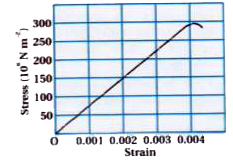
View SolutionThe stress-strain graphs for materials A and B
The graphs are drawn to the same scale.
(a) Which of the materials has the greater Young's modulus ?
(b) Which of the two is the stronger material ?

View SolutionRead the following two statements below carefully and state, with reasons, if it is true or false,
(a) The Young's modulus of rubber is greater than that of steel,
View SolutionTwo wires of diameter 0.25 cm, one made of steel and the other made of brass are loaded as shown in figure. The unloaded length of steel wire is 1.5 m and that of brass wire is 1.0 m. Compute the elongations of the steel and the brass wires.
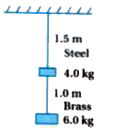
View SolutionThe edge of an aluminium cube is 10 cm long. One face of the cube is firmly fixed to a vertical wall. A mass of 100 kg is then attached to the opposite face of the cube. The shear modulus of aluminium is 25 GPa. What is the vertical deflection of this face ?
View SolutionFour identical hollow cylindrical columns of mild steel support a big structure of mass 50,000 kg. The inner and outer radii of each column are 30 and 60 cm respectively. Assuming the load distribution to be uniform, calculate the compressional strain of each column.
View SolutionA piece of copper having a rectangular cross section of 15.2 mm x 19.1 mm is pulled in tension with 44,500 N force, producing only elastic deformation. Calculate the resulting strain.`Y_(Cu)=1.2 xx 10 ^(11) N//m^(2).`
View SolutionA steel cable with a radius of 1.5 cm supports a chairlift at a ski area. If the maximum stress is not to exceed `108 Nm^(-2),` what is the maximum load the cable can support?
View SolutionA rigid bar of mass 15 kg is supported symmetrically by three wires each 2.0 m long. Those at each end are of copper and the middle one is of iron. Determine the ratios of their diameters if each is to have the same tension. `Y_(Cu)=1.2 xx 10 ^(11) N m ^(-2), Y_(Fe) = 1.9 xx 10 ^(11) N, ^(-2)`
View SolutionA 14.5 kg mass, fastened to the end of a steel wire of unstretched length 1.0 m, is whirled in a vertical circle with an angular velocity of 2 rev/s at the bottom of the circle. The crosssectional area of the wire is 0.065 cm. Calculate the elongation of the wire when the mass is at the lowest point of its path. `[Y_("Steel") =2 xx 10 ^(11) N,m ^(-2)]`
View SolutionCompute the bulk modulus of water from the following data: Initial volume = 100.0 litre, Pressure increase = 100.0 atm `(1 atm = 1. 013xx 10^(5) Pa),` Final volume = 100.5 litre. Compare the bulk modulus of water with that of air (at constant temperature). Explain in simple terms why the ratio is so large.
View SolutionWhat is the density of water at a depth where pressure is 80.0 atm, given that its density at the surface is `1.03 xx 10 ^(3)kgm ^(-3)?` Compressibility of water `45.8 10 ^(-11) Pa ^(-1), [1 Pa =1 Nm ^(-2)]`
View SolutionCompute the fractional change in volume of a glass slab, when subjected to a hydraulic pressure of 10 atm.
View SolutionDetermine the volume contraction of a solid copper cube, 10 cm on an edge, when subjected to a hydraulic pressure of `7.0 xx 10 ^(6)` Pa. (Bulk Modulus `B=1.4xx 10 ^(11)`)
View SolutionHow much should the pressure on a litre of water be changed to compress it by 0.10 % ? `(B=2.2 xx 10 ^(9) N//m^(2))`
View SolutionAnvils made of single crystals of diamond, with the shape as shown in figure, are used to investigate behaviour of materials under very high pressures. Flat faces at the narrow end of the anvil have a diameter of 0.50 mm, and the wide ends are subjected to a compressional force of 50,000 N. What is the pressure at the tip of the anvil ?
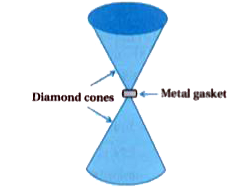
View SolutionA rod of length 1.05 m having negligible mass is supported at its ends by two wires of steel (wire A) and aluminium (wire B) of equal lengths as shown in figure. The cross-sectional areas of wires A and B are 1.0 `mm^(2)` and 2.0 `mm^(2),` respectively. At what point along the rod should a mass m be suspended in order to produce (a) equal stresses and (b) equal strains in both steel and aluminium wires.
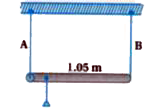
View SolutionA mild steel wire of length 1.0 m and cross sectional area `0.50 xx 10 ^(-2) cm^(2)` is stretched, well within its elastic limit, horizontally between two pillars. A mass of 100 g is suspended from the mid-point of the wire. Calculate the depression at the midpoint.
View SolutionTwo strips of metal are riveted together at their ends by four rivets, each of diameter 6.0 mm. What is the maximum tension that can be exerted by the riveted strip if the shearing stress on the rivet is not to exceed `6.9 xx 10 ^(7)` Pa ? Assume that each rivet is to carry one quarter of the load.
View SolutionThe Marina trench is located in the Pacific Ocean, and at one place it is nearly eleven km beneath the surface of water. The water pressure at the bottom of the trench is about `1.1 xx 10 ^(8)` Pa. A steel ball of initial volume `0.32 m^(3)` is dropped into the ocean and falls to the bottom of the trench. What is the change in the volume of the ball when it reaches to the bottom ?
View SolutionA steel wire of length 5 m and diameter `10^(-3)` m is hanged vertically from a ceiling of 5.22 m height. A sphere of radius 0.1 m and mass 8tt kg is tied to the free end of the wire. When this sphere is oscillated like a simple pendulum, it touches the floor of the room in its velocity of the sphere in its lower most position. Calculate the velocity of the sphere in its lower Young's modulus for in its lower most position. Young's modulus for steel `=1.994 xx 10 ^(11) Nm ^(-2).`
View SolutionA mass of 15 kg is tied at the end of a steel wire of the length lm. It is whirled in a vertical plane with angular velocity 1 rad/s. Cross sectional area of the wire is `0.06 cm^(2).` Calculate the elongation of the wire when the mass is at its lowest position. `Y_("steel”) = 2 xx 10 ^(11) Nm ^(-2)`
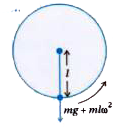
View SolutionAs shown in figure 10 N force is applied at two ends of a rod. Calculate tensile stress and searing stress for section PR, Area of cross section PQ is 10 `cm^(2).`

View SolutionLength and cross sectional area of a wire are 5 m and `2.5 mm^(2).` Calculate work required to be done to increase its length by 1 mm. Young's modulus of material of wire `=2 xx 10 ^(11) Nm ^(-2)`
View SolutionFigure shows a composite rod of cross-sectional area `10^(-4) m^(2)` made by joining three rods AB, BC and CD of different materials end to end. The composite rod is suspended vertically and an object of 10 kg is hung by it. `L _(AB) =0.1 m, _(BC) =0.2 m and L _(CD) =0.15 m.`
Calculate displacement of `B,C and D Y_(AB) =2.5 xx 10 ^(10) Pa, Y_(BC) = 4 xx 10 ^(10) Pa and Y_(CD) = 1 xx 10 ^(10) Pa.`

View SolutionA wire of length L and cross section area A is kept on a horizontal surface and one of its end is fixed at point 0. A ball of mass m is tied to its other end and the system is rotated with angular velocity `omega.` Show that increase in its length. `Delta l = (m omega ^(2) L ^(2))/(AY). Y` is young’s modulus.
View SolutionAs shown in figure, masses of 2 kg and 4kg are tied to two ends of a wire passed over a pulley. Cross-sectional area of wire is `2 cm^(2).` Calculate longitudinal strain produced in wire. `(g = 10 ms ^(-2) Y= 2 xx 10 ^(11) Pa`
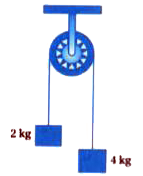
View SolutionA steel wire of cross section 1 mm2 is heated at `60^(@)` C and tied between two ends family. Calculate change in tension when temperature becomes `30^(@) C` coefficient of linear expansion for steel is `alpha = 1.1 xx 10 ^(-5) "”^(@)C ^(-1), Y =2 xx 10 ^(11) Pa.` (Change in length of wire due to change in temperature `(Delta t) is Delta l = alpha l Delta t)`
View SolutionFigure shows a wire of length 2L and crosssectional area A, stretched horizontally between two clamps. When an object of mass M is suspended from the mid point of the wire, the downward displacement of the young's modulus of the material of the wire is x. Shown that `M = (YA x ^(3))/(gL ^(3)) ` (where `theta` is small)
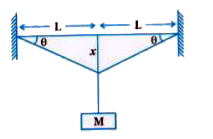
View SolutionAn object of mass 5 kg is suspended by a copper wire of length 2 m and diameter 5 mm. Calculate the increase in the length of the wire. In order not to exceed the elastic limit, what should be the minimum diameter of the wire ? For copper, elastic limit `=1.5 xx 10 ^(9) "dyne" //cm ^(2) , (Y) = 1.1 xx 10 ^(12) "dyne"//cm^(2).`
View SolutionDerive an expression for elastic potential energy per unit volume stored for the wire is
`1/2 xx` stress `xx` strain.
View Solution
SECTION-B questions and complete solutions for chapter MACHANICAL PROPERTIES OF SOLIDS of KUMAR PRAKASHAN KENDRA PHYSICS (GUJRATI ENGLISH) of Class 11